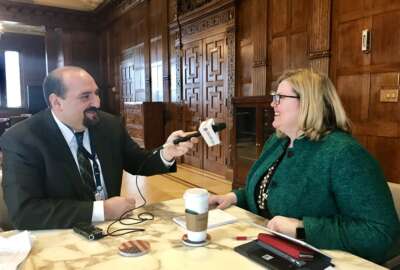GSA’s next set of acquisition modernization initiatives to focus on services, automation, data
Sonny Hashmi, the commissioner of the Federal Acquisition Service at GSA, said with the initial Federal Marketplace Strategy initiatives almost complete, FAS is...
The General Services Administration has almost completed its first set of initiatives under the Federal Marketplace Strategy.
GSA’s Federal Acquisition Service created a foundation over the last few years that focused on improving the customer and employee experiences.
Now FAS is ready to build on that foundation with four new initiatives that will expand the use of technology, further the buying and selling experiences in GSA’s $75 billion marketplace and bring more and better data to those who need it to make decisions.

“We’re going to be adding four additional cornerstones. Under that umbrella are a products marketplace, which is going to include both GSA Advantage as well as the commercial marketplace initiative; a services marketplace, which starts to address those questions around, what is our service contract strategy? What are the multiple award contracts (MACs)? What are the governmentwide acquisition contracts (GWACs)? What are the schedules? Where are the gaps? How do we deliver most value, reduce burden on the vendor community? We’re going to start to think really deeply about like the next iteration of catalog management. Similarly, we’re going to be focusing on data and other automation opportunities to reduce friction,” FAS Commissioner Sonny Hashmi said during the recent Coalition for Government Procurement Conference, which was on Ask the CIO. “We are working on a set of systems processes and experiences that have been built over the last 30 years. In fact, today, there are systems running that are 40 years old. It’s not just about putting a new lipstick on the same back end, it’s not about just adding a little automation to connect the dots, we have to fundamentally rethink some of these things. And that fundamental rethink requires time and effort.”
While Hashmi said more details are coming about the new initiatives, the end goal of the federal marketplace strategy remains the same: Reduce friction for agency customers and contractors selling the products and services.
“If you look at the transactions that are going through, the majority are in the service marketplaces, whether it’s in IT or non-IT services. Then we have a products catalog marketplace, and those experiences are slightly different how you buy a product is slightly different than how you engage with a vendor on services. We have to kind of provide that distinction,” he said. “When it comes to products, we’re seeing customers increasingly wanting to see a self-service type model, more of an e-commerce model. So that begs the question of what’s the future of GSA Advantage? How do we scale it? How do we make it more powerful? Then, of course, there’s a new policy frameworks coming our way from Section 889, supply chain risk management, cybersecurity and cybersecurity maturity model certification (CMMC) compliance. We have to incorporate all of those as part of our thinking as well.”
The four new initiatives follow the efforts over the last few years to modernize and consolidate the schedule contracts, develop commercial platforms under Section 876, develop a contract acquisition lifecycle management system, and move toward a catalog management for all products and services.
Older deadlines still coming
Hashmi said the schedule consolidation effort is about 90% complete, and there are several deadlines coming for the other three initiatives.
“We don’t have a consistent and common contract management platform and as a result, we don’t have the data points on where things are getting stuck. We don’t have consistency in some of the processes that we’re trying to implement. So having that platform in place is foundational for us to build on,” he said. “Similarly, the commercial marketplace pilot has been early stages to kind of really explore a new model of doing transactional, low-dollar value, high-transaction volume business, we now have some data points that we’re working on. We believe that there’s a place for that strategy alongside our own e-commerce platform called Advantage. We’re going to start to work on that phase two strategy as you move forward.”
Tom Howder, the deputy commissioner at FAS, said GSA expects to make an award toward the end of the fiscal 2021 for help developing the catalog management system.
He said the vendor will help manage data and the catalog listings.
“Our focus is on the user experience. We are putting the fundamentals in place and that is where the user will see changes,” Howder said at the Coalition conference. “We want to make it easier for contractors to get on GSA contracts. We know it’s a lot of systems they have to deal with. We will make it a more streamlined and easier process. It’s part of how we are reimagining our digital experience.”
Customer experience is the common thread through the first four federal marketplace initiatives and the next four.
GSA, which just closed out is annual customer survey on June 30, said the results of its customer loyalty survey and supplier relationship management survey reached all-time highs last year. The FAS supplier satisfaction increased from 3.7 in 2019 to 3.8 in 2020 (on a 5-point scale). The 2020 FAS supplier satisfaction score is an all-time high for GSA, which it began tracking in 2013.
Hashmi said the focus on the customer is driving its request for information about possibly setting up a new cloud services blanket purchase agreement as well as the new services multiple award contract to replace OASIS.
OASIS replacement not final
He said the OASIS replacement remains a work in progress in all regards.
“If agencies and customers and vendors are comfortable competing in that environment, we want to make sure that that environment stays healthy and viable. But there’s other requirements that are coming our way that we also need to address,” Hashmi said. “When you think of highly innovative companies that have deep expertise around specialized areas, like healthcare or advisory services, we want to be able to make sure that the contract has flexibility to be able to address those, that doesn’t mean that every competition, every task order is going to go through all of this competitive environment. That’s why we’re looking at a pooling structure so that you can actually identify the right pool for you based on the time of need.”
Hashmi added FAS is cognizant that the more GWACs and multiple award contracts they create—and there are several in the works along with the OASIS replacement including POLARIS, ASTRO and the recently awarded 8(a) STARS III — the more confusion and burden they could bring.
“Give us some time. We don’t want to break what works. Industry should not worry that we’re going to take opportunity away from them,” he said. “If you’re a company that’s been very successful on OASIS, engage in the [the OASIS replacement] conversation, make sure that you are also going to be very successful on the new contract. But if you’re a company that was left out of OASIS, guess what, you now have an opportunity to also be successful in the new contract vehicle. That’s where I’m looking at it. Now, we want to make sure that we talk constantly with our customers and our suppliers. So we can wait until this thing gets released and then say, ‘Well, this is not going to work for us.’ Or you can engage with us now to make sure we build something that’s going to actually work for you. We’re a couple years away from this being fully figured out and issued. That’s plenty of time for us to rethink how we are going to do competition. Engage with us, give us some ideas, and then let’s make it so that it’s accessible for you.”
Copyright © 2024 Federal News Network. All rights reserved. This website is not intended for users located within the European Economic Area.
Jason Miller is executive editor of Federal News Network and directs news coverage on the people, policy and programs of the federal government.
Follow @jmillerWFED








